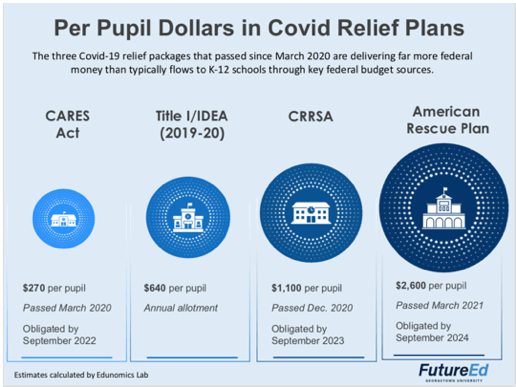SCHOOLS: Obtain Funding
Federal Stimulus
Bills Dramatically
Expand Funding
& for Career and
Technical Education (CTE)
— How to Tap THE single
largest federal cash infusion
for education in history
It’s being called one of the most significant and exciting “windows of opportunity” for the educational arena in decades. The federal government, as part of their COVID-19 response, has passed three separate stimulus bills to help address the pandemic’s enormous impact on K-12 and higher education.
A “Once-in-a-Generation” Opportunity
While most of the money in K-12 has been disbursed according to Title I formulas, these programs offer an unprecedented, once-in-a-generation opportunity for the education arena—the largest single infusion of federal investment in schools ever made.
While most of the money in K-12 has been disbursed according to Title I formulas, these programs offer an unprecedented, once-in-a-generation opportunity for the education arena—the largest single infusion of federal investment in schools ever made.
CTE Is “Under the Umbrella”
What’s especially significant is how this funding promises to bolster Career and Technical Education (CTE). While CTE has historically been supported by funds from the Perkins Act, districts and schools can also use the stimulus funds provided by these three new bills for the same types of programs and activities as those covered under the Perkins Act.
What’s especially significant is how this funding promises to bolster Career and Technical Education (CTE). While CTE has historically been supported by funds from the Perkins Act, districts and schools can also use the stimulus funds provided by these three new bills for the same types of programs and activities as those covered under the Perkins Act.
The bulk of the money has now been disbursed by the states to local school districts. The table below outlines the funds-obligation dates of each stimulus package, and its spending deadline.
| Congressional Bill | Signed into Law | PK-12 Allocation | Obligation Deadline | Spending Deadline |
|---|---|---|---|---|
| CARES Act | March 2020 | $13.5 billion | December 30, 2021 | September 30, 2022 |
| CRRSA | December 2020 | $54.3 billion | September 30, 2022 | September 30, 2023 |
| American Rescue Plan | March 2021 | $122 billion | September 30, 2023 | September 30, 2024 |
| Congressional Bill | Signed into Law | PK-12 Allocation | Obligation Deadline | Spending Deadline |
|---|---|---|---|---|
| CARES Act | March 2020 | $13.5 billion | December 30, 2021 | September 30, 2022 |
| CRRSA | December 2020 | $54.3 billion | September 30, 2022 | September 30, 2023 |
| American Rescue Plan | March 2021 | $122 billion | September 30, 2023 | September 30, 2024 |
“What types of activities can the money from these three bills be used to fund?”
All three bills can be used to fund activities authorized by the:
- Elementary and Secondary Education Act (IDEA)
- Every Student Succeeds Act (ESSA)
- Individuals with disabilities Education Act (IDEA)
- Adult Education and Family Literacy Act
- Perkins Career & Technical Education Act (CTE)
- McKinney-Vento Homeless Assistance Act
“What sort of supplemental monetary impact on “per-student” spending will the new stimulus funding bills provide?”
As outlined in the chart below (courtesy of Georgetown University’s FutureEd think tank), the stimulus bills offer more than $4600 additional funding per student—yes, over and above what school districts currently receive.

“Besides the activities covered by the education laws listed above, are there other expenses eligible for funding by these three stimulus bills?”
Yes, other qualifying expenses include:
- The purchase of education technology, including hardware, software, connectivity, assistive technology, or adaptive equipment
- Summer learning and supplemental afterschool programs, including instruction or online learning
- Activities necessary to maintain continuity of services, including retaining existing staff
- Addressing learning loss by:
- Administering high-quality assessments
- Implementing evidence-based activities to meet student needs
- Providing information and assistance to parents and families on ways to support students
- Tracking student performance and engagement in distance-learning environments
Bonus Funding Benefit: Boosting Bandwidth & High-Tech Access
It’s estimated that 16 million K-12 students and 400,000 educators lack high-quality home internet services and/or devices. To ameliorate this key deficiency, and in addition to the direct federal funding for education, the $122 billion American Rescue Plan has allocated $7 billion to the Federal Communication Commission’s (FCC) E-Rate program, designed to equip students and educators in underserved areas with internet access and devices.
Certify-ED IS CTE!
Certify-ED’s critically acclaimed, multiple-award-winning online curriculum falls squarely in the “funds-eligible” CTE category. What sets our programming apart?
- Hands-on simulations and virtual reality (VR) engage and captivate students
- Short video-style lessons reinforce progress and cement lessons
- Courses expose kids to exciting potential career directions
- Exceptionally user-friendly for students, teachers and administrators
- Easily integrates into existing Learning Management Systems (LMS)
- Turnkey custom-curriculum creation possible—to your specs
- “Certification-focused” curriculum
- Industry-leading, ID-verifying application ensures integrity of certifying exams
- Winner of more than two dozen industry awards in our first three years
Ready to Learn More?
Visit www.certify-ed.com/tellmemore. Ready to book a demo or set up a no-obligation consultation to further explore Certify-ED’s critically acclaimed offerings? Contact CEO Lynne Henderson at 800-970-1393 or lynne.henderson@certify-ed.com.
In addition to the direct federal funding for education, the American Rescue Plan allocates $7 billion to the Federal Communication Commission’s (FCC) E-Rate program, which equips students and educators with internet access and devices. It is estimated that 16 million K-12 students, and 400,000 educators, lack high-quality home internet services and/or devices.

